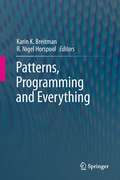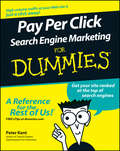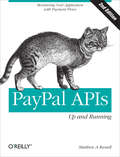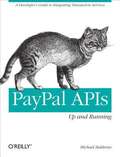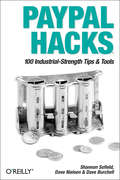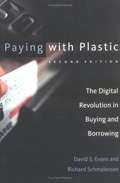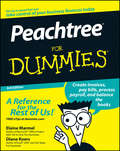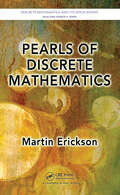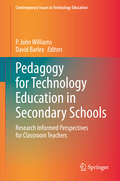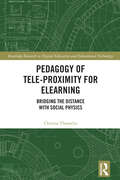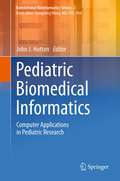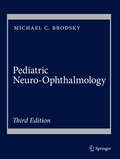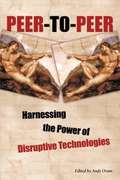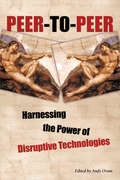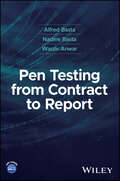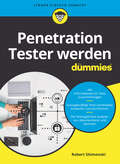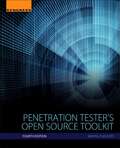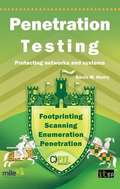- Table View
- List View
Patterns, Programming and Everything
by Karin K. Breitman R. Nigel HorspoolWith 11 invited submissions from leading researchers and teams of researchers sharing one common characteristic ? all have worked with Dr. Judith Bishop during her long and continuing career as a leader in computer science education and research ? this book reflects on Dr Bishop?s outstanding contribution to computer science. Having worked at three different universities she now holds a leadership position in the research division of a major software company. The topics covered reflect some of the transitions in her career. The dominant theme is programming languages, with chapters on object oriented programming, real-time programming, component programming and design patterns. Another major and related topic is compilers, with contributions on dataflow analysis, tree rewriting and keyword recognition. Finally, there are some additional chapters on other varied but highly interesting topics including smart homes, mobile systems and teaching computer science.
Pay Per Click Search Engine Marketing For Dummies
by Peter KentPlan and launch your PPC campaign and keep track of its progress If you want potential customers to form a traffic jam at your Web site, Pay Per Click just might do the trick. This book will help you decide! It tells you all about Google AdWords and Yahoo! Sponsored Search, targeting your customers, watching out for fraud, assessing the pros and cons of Pay Per Click, and making Pay Per Click work for you. Discover how to Use the right keywords to trigger your ads Figure your breakeven point Write ads that reach your customers Calculate return on investment Use geo targeting Track your ad results
PayPal APIs: Monetizing Your Application with Payment Flows
by Matthew A. RussellIf your web application’s success depends on how quickly and easily users can make transactions, PayPal APIs provide effective solutions you can’t afford to overlook. This concise book takes you hands-on through several options to help you determine the best choice for your situation, whether you’re collecting money via websites or mobile apps for products and services, donations, or anything else.In each chapter, you’ll work with a different PayPal API by integrating it into the book’s sample application, using Python and the Google App Engine framework. This expanded edition introduces two new options: Express Checkout for Digital Goods and Instant Payment Notifications, complete with sample project code. By the end of this book, you’ll understand how to take full advantage of PayPal and its powerful features.Learn PayPal API basics, and get an introduction to Google App EngineExplore the Express Checkout option, and understand what distinguishes it from other generic workflowsTailor Express Checkout for electronic documents, videos, and other “in app” digital purchasesApply the Adaptive Payments option for transactions that involve multiple recipientsEmbed the payment process into your site with no mention of PayPal, using Website Payments ProUse the Instant Payment Notifications you receive as triggers to take follow-up action
PayPal APIs: Up and Running
by Michael BalderasIf your web application's success depends on how quickly and easily users can make transactions, then PayPal is a solution you can't afford to overlook. This book helps you determine which PayPal option is best for your situation, and provides step-by-step instructions for implementing the payment method you choose--whether you're accepting money via the Web or mobile devices for products and services, donations, or anything else. You'll find sample code written primarily in PHP and Objective-C, as well as use cases for executing options with PayPal's API. By the end of this book, you'll have a clear understanding of PayPal and how you can get the most out of its powerful features, no matter how much API programming experience you have. Learn how to work with the PayPal API, and choose the right integration method for your project Explore PayPal's Express Checkout option, including its unique workflow and four methods of operation Examine the Website Payment Pro method--with a focus on direct payments Consider Adaptive Payments and learn how to set permission levels for their use Use PayPal in your iOS or Android-based mobile app with the new Mobile Express Checkout method Test your PayPal implementation with the sandbox
PayPal Hacks: 100 Industrial-Strength Tips & Tools (Hacks)
by Shannon Sofield Dave Nielsen Dave BurchellIf you've bought or sold items through eBay, or through hundreds of other online sites, then you're familiar with PayPal, the online payment service. With PayPal, a valid email address, and a credit card or bank account, you can easily send and receive payments online. Not a bank or financial institution itself, PayPal describes its service as one that builds on the financial infrastructure of bank accounts and credit cards, and using advanced propriety fraud prevention systems, creates a safe, global, real-time payment solution. Put simply, PayPal provides the means for people to conduct financial transactions online, instantly and securely.But there's more to PayPal than meets the eye. PayPal Hacks shows you how to make the most of PayPal to get the most out of your online business or transactions. Authors Shannon Sofield of Payloadz.com and PayPal evangelist David Nielsen guide you through the rigors of using and developing with PayPal. Whether you're building an ecommerce site using PayPal as a transaction provider, or simply trying to pay for an eBay auction without getting burned, PayPal Hacks will give you the skinny on this leading global online payment service.The collection of tips and tricks in PayPal Hacks shows you how to find or even build the right tools for using PayPal to buy and sell on eBay or as a transaction provider for ecommerce on your own site. Written for all PayPal users, from those just starting out to those developing sophisticated ecommerce sites, this book begins with the basics such as setting up your account, then moves quickly into specific tips and tools for buyers, sellers, and developers.With PayPal Hacks, you can:Learn extra steps to help protect yourself while buying or selling on eBaySave time and money with advanced tips and undocumented featuresLearn dozens of easy-to-follow procedures to help you request and receive payments and fill ordersUse PayPal to handle subscriptions, affiliate systems, and donationsCreate and customize your customers' checkout processEffortlessly integrate PayPal's shopping cart system into your own websiteImplement digital fulfillment with Instant Payment Notification (IPN) and Payment Data Transfer (PDT)Develop and distribute ecommerce applications with the PayPal APIEach hack consists of a task to be accomplished or a creative solution to a problem, presented in a clear, logical, and task-oriented format. PayPal Hacks provides the tools and details necessary to make PayPal more profitable, more flexible, and more convenient.
Payara Micro Revealed: Cloud-Native Application Development with Java
by David R. HeffelfingerDevelop, configure, and deploy Java cloud-native applications using Payara Micro. This book demystifies Java cloud-native application development using standard Microprofile APIs and covers Payara-specific features such as automatic clustering and application initialization performance improvements. You will learn how to improve startup performance by taking advantage of class data sharing, and configure cloud-native applications via standard development tools such as Maven and Gradle. The book also clarifies how to develop functionality necessary in a cloud environment, such as health checks and request tracing, using MicroProfile APIs. The book begins by showing how to develop microservices using RESTful web services, followed by how to create microservice clients using MicroProfile and the REST client API. Dependency Injection via Jakarta Context and Dependency Injection (CDI) is also covered. Various approaches to application configuration are covered as well, including property files, environment variables, and system properties. You will learn to configure fault tolerance and high availability, generate system and custom application metrics, and generate health checks to automatically improve overall application health. You will know how to trace the flow of a request across service boundaries with OpenTracing. You will be able to make future maintenance easily through generating documentation, including how to automatically update documentation as your code is updated. Additionally, you will learn how to secure cloud applications and to automatically cluster applications and improve application startup performance.What You Will LearnDevelop microservices using standard Java APIsImplement cloud functionality such as request tracing and health checksDeploy applications as thin archives and as uber archivesConfigure applications via Maven and GradleGenerate custom metrics for capacity planning and proactive discovery of issuesImplement features in support of high availability and fault toleranceSecure your applications with Jason Web TokensTake advantage of Payara’s own cloud platform for easy deploymentWho This Book Is ForJava developers who wish to develop cloud-native applications and microservices, and Java EE application developers who wish to transition to developing cloud-native applications that are lightweight and easily deployed
Paying with Plastic: The Digital Revolution in Buying and Borrowing
by David Evans Richard SchmalenseeThe payment card business has evolved from its inception in the 1950s as a way to handle payment for expense-account lunches (Diners Club card) into today's complex, sprawling industry that drives trillions of dollars in transaction volume each year.
Peachtree For Dummies
by Elaine Marmel Diane KoersNot feeling too peachy about computerizing your accounting system? Relax! Peachtree For Dummies, 3rd Edition will show you how to set up your company in Peachtree and then use it to pay bills, invoice customers, pay employees, produce financial reports, and more. You'll quickly discover how Peachtree can save you time, effort, and money so that you no longer have to do your accounting by hand or pay someone else to do it for you.Publishing to coincide with the latest release of Peachtree, this third edition is revised to cover the newest updates and enhancements made to the most recent version of Peachtree. Veteran authors Elaine Marmel and Diane Koers break down the capabilities of Peachtree Premium Accounting, from building an effective chart of accounts, to customizing forms and modifying reports, to setting up default information that will save you time down the line. You'll also discover how to:Work with purchase ordersSell products and servicesGenerate invoicesTrack project costsProduce income statementsBack up and restore dataBalance accountsManage inventoryHandle customer prepaymentsPay for purchase orders with a credit cardKeep your account information safePacked with examples of everyday, real-life situations, Peachtree For Dummies, 3rd Edition is the reference you need so that you can put Peachtree to work for you and get the job done quickly and correctly.
Pearls of Discrete Mathematics (Discrete Mathematics and Its Applications)
by Martin EricksonMethods Used to Solve Discrete Math ProblemsInteresting examples highlight the interdisciplinary nature of this areaPearls of Discrete Mathematics presents methods for solving counting problems and other types of problems that involve discrete structures. Through intriguing examples, problems, theorems, and proofs, the book illustrates the relation
Pedagogy and Learning with ICT: Researching the Art of Innovation
by Bridget SomekhBridget Somekh draws on her experience of researching the introduction of ICT into education to look at ICT development over the last twenty years. The book provides a fascinating, in-depth analysis of the nature of learning, ICT pedagogies and the processes of change for teachers, schools and education systems. It covers the key issues relating to the innovation of ICT that have arisen over this period, including: the process of change educational vision for ICT teacher motivation and engagement the phenomenon of ‘fit’ to existing practices systemic constraints policy and evaluation of its implementation students’ motivation and engagement the penetration of ICT into the home online learning and the ‘disembodied’ teacher.
Pedagogy for Technology Education in Secondary Schools: Research Informed Perspectives for Classroom Teachers (Contemporary Issues in Technology Education)
by David Barlex P. John WilliamsThis book explores pedagogy appropriate for the secondary school technology education classroom. It covers the dimensions of pedagogy for technology with scholarly research, including information strongly related to practice. The book discusses the nature of technology courses in secondary schools across various jurisdictions and considers how they might be viewed with regard to different epistemological frameworks. The writing is informed by, but not limited to, research and strongly related to practice with acknowledged experts in the field of technology education contributing chapters supported by evidence from technology education research or other fields. The authors speculate on pedagogical possibilities in their areas of expertise in order to consider pedagogical possibilities and develop a view of where pedagogy for technology education should move and how teachers might respond in the way they develop their practice.
Pedagogy of Tele-Proximity for eLearning: Bridging the Distance with Social Physics (Routledge Research in Digital Education and Educational Technology)
by Chryssa ThemelisThis book examines networked science and the pedagogy of tele-proximity, a paradigm that integrates eLearning theories, information technology and visual media competencies. The book conceptualises the idea of tele-proximity as a means to foster diversity and human to human contact online. It uses the lens of social physics and considers how to bridge the distance in eLearning, examining social connections, collective intelligence and personal wellbeing. The book draws on qualitative and quantitative research in higher education to form fine-tuned eLearning networks that achieve demosophia, the core of democracy. It charts the progress of technology-enhanced learning approaches and shows the need for a sound pedagogical framework that is holistic and sustainable to promote mindful presence. Contributing to the literature on eLearning, this timely book will be of great interest to educational philosophers, policy makers, educators, researchers and students in the field of distance education.
Pediatric Biomedical Informatics
by John J. HuttonAdvances in the biomedical sciences, especially genomics, proteomics, and metabolomics, taken together with the expanding use of electronic health records, are radically changing the IT infrastructure and software applications needed to support the transfer of knowledge from bench to bedside. Pediatric Biomedical Informatics: Computer Applications in Pediatric Research describes the core resources in informatics necessary to support biomedical research programs and how these can best be integrated with hospital systems to receive clinical information that is necessary to conduct translational research.The focus is on the authors' recent practical experiences in establishing an informatics infrastructure in a large research-intensive children's hospital. This book is intended for translational researchers and informaticians in pediatrics, but can also serve as a guide to all institutions facing the challenges of developing and strengthening informatics support for biomedical research. The first section of the book discusses important technical challenges underlying computer-based pediatric research, while subsequent sections discuss informatics applications that support biobanking and a broad range of research programs. Pediatric Biomedical Informatics provides practical insights into the design, implementation, and utilization of informatics infrastructures to optimize care and research to benefit children. Dr. John Hutton is the Vice President and Director of Biomedical Informatics at Cincinnati Children's Hospital Medical Center, Cincinnati, OH, USA. He is also Professor of Pediatrics and Associate Dean for Information Services at the University of Cincinnati College of Medicine.
Pediatric Neuro-Ophthalmology
by Michael C. Brodsky"Due to the generous representation of the afferent visual system within the brain, neurological disease may disrupt vision as a presenting symptom or as a secondary effect of the disease. Conversely, early developmental disturbances of vision often disrupt ocular motor control systems, giving rise to complex disorders such as nystagmus, strabismus, and torticollis. The signs and symptoms of neurological disease are elusive by their very nature, presenting a confounding diagnostic challenge. Neurological medications and neurosurgical treatments can produce neuro-ophthalmological dysfunction that can be difficult to distinguish from disease progression. Affected patients may experience substantial delays in diagnosis, and are often subjected to extensive (and expensive) diagnostic testing. Scientific articles pertaining to specific disorders are scattered throughout medical subspecialty journals. These children continue to "fall through the cracks" of our medical education system. The increasing recognition that pediatric neuro-ophthalmology comprises a distinct set of diseases from those seen in adults has led to its emergence as a dedicated field of study. "Since the original publication of Pediatric Neuro-Ophthalmology nearly fourteen years ago, interest in the field has burgeoned. Pediatric ophthalmology and pediatric neurology subspecialty conferences often include symposia dedicated to recent advances in pediatric neuro-ophthalmology. Technical advances in neuroimaging have given rise to a more integrated mechanistic classification of neuro-ophthalmological disease in children. Our understanding of neurodevelopmental disorders of the visual system has expanded, longstanding monoliths have been dissembled into component parts, basic molecular mechanisms have taken center stage, and genetic underpinnings have become definitional. Evolutionary alterations can now be observed at the level of the gene, adding a new dimension to our understanding of disease pathogenesis. New classifications now encompass clinically disparate conditions. Descriptive definitions have been supplanted by mechanistic ones, and clinical definitions superseded by genetic ones. Our concept of disease pathogenesis has been revised and in some cases overturned. Bearing witness to these remarkable advancements has compelled me to enhance and expand the first edition of Pediatric Neuro-Ophthalmology into this new and revised one. "In the first edition of this book, our goal was to present the clinical characteristics, diagnostic evaluation, and therapeutic options for the common neuro-ophthalmologic disorders of childhood. In so doing, we designed the book to be provide a narrative journey through the thought processes involved in the clinical management of these disorders. In this edition, I have retained the basic narrative format of original book, while expanding the exploration of these complex visual disorders in the context of the many new scientific advancements and discoveries that have come to light. These conditions are fun to diagnose, fascinating to understand, and gratifying to manage." --from the Preface to the 2nd Edition.
Pediatric and Lifespan Data Science: First International Conference, IPLDSC 2024, Anaheim, CA, USA, May 23–24, 2024, Revised Selected Papers (Communications in Computer and Information Science #2386)
by Mark Hoffman Louis Ehwerhemuepha Adam Kalawi Terence SangerThis open access book will address the unique requirements and technological tools for analysis of data across the lifespan, from childhood through advanced age. Topics such as sepsis, hospital-acquired infections, mental health, health equity, precision medicine, large language models and generative artificial intelligence, computer vision, ethical use of artificial intelligence, and large real-world electronic health record databases will be covered.
Peer Pedagogies on Digital Platforms: Learning with Minecraft Let's Play Videos (Learning in Large-Scale Environments)
by Michael DezuanniHow a popular entertainment genre on YouTube--Let's Play videos created by Minecraft players--offers opportunities for children to learn from their peers.Every day millions of children around the world watch video gameplay on YouTube in the form of a popular entertainment genre known as Let's Play videos. These videos, which present a player's gameplay and commentary, offer children opportunities for interaction and learning not available in traditional television viewing or solo video gameplay. In this book, Michael Dezuanni examines why Let's Play videos are so appealing to children, looking in particular at videos of Minecraft gameplay. He finds that a significant aspect of the popularity of these videos is the opportunity for knowledge and skill exchange.
Peer to Peer
by Rael Dornfest David Anderson Nimisha Asthagiri Dan Brickley Dan Bricklin Alan Brown Avinash Chugh Lorrie Cranor Roger Dingledine Michael Freedman Marc Hedlund Theodore Hong Gene Kan Adam Langley Richard Lethin Jeremie Miller Nelson Minar David Molnar Tim O'Reilly Aviel Rubin Clay Shirky Walter Tuvell Jon Udell Marc Waldman Brandon WileyThis book presents the goals that drive the developers of the best-known peer-to-peer systems, the problems they've faced, and the technical solutions they've found. The contributors are leading developers of well-known peer-to-peer systems, such as Gnutella, Freenet, Jabber, Popular Power, SETI@Home, Red Rover, Publius, Free Haven, Groove Networks, and Reputation Technologies. Topics include metadata, performance, trust, resource allocation, reputation, security, and gateways between systems.
Peer-To-Peer: Harnessing the Benefits of a Disruptive Technology (First Edition)
by Andy OramThis book is about the goals of peer-to-peer computer networking, its problems and solutions.
Peer-to-Peer Computing: Applications, Architecture, Protocols, and Challenges (Chapman & Hall/CRC Computational Science)
by Yu-Kwong Ricky KwokWhile people are now using peer-to-peer (P2P) applications for various processes, such as file sharing and video streaming, many research and engineering issues still need to be tackled in order to further advance P2P technologies. Peer-to-Peer Computing: Applications, Architecture, Protocols, and Challenges provides comprehensive theoretical and p
Peer-to-Peer: Harnessing the Power of Disruptive Technologies
by Andy OramThe term "peer-to-peer" has come to be applied to networks that expect end users to contribute their own files, computing time, or other resources to some shared project. Even more interesting than the systems' technical underpinnings are their socially disruptive potential: in various ways they return content, choice, and control to ordinary users.While this book is mostly about the technical promise of peer-to-peer, we also talk about its exciting social promise. Communities have been forming on the Internet for a long time, but they have been limited by the flat interactive qualities of email and Network newsgroups. People can exchange recommendations and ideas over these media, but have great difficulty commenting on each other's postings, structuring information, performing searches, or creating summaries. If tools provided ways to organize information intelligently, and if each person could serve up his or her own data and retrieve others' data, the possibilities for collaboration would take off. Peer-to-peer technologies along with metadata could enhance almost any group of people who share an interest--technical, cultural, political, medical, you name it.This book presents the goals that drive the developers of the best-known peer-to-peer systems, the problems they've faced, and the technical solutions they've found. Learn here the essentials of peer-to-peer from leaders of the field:Nelson Minar and Marc Hedlund of target="new">Popular Power, on a history of peer-to-peerClay Shirky of acceleratorgroup, on where peer-to-peer is likely to be headedTim O'Reilly of O'Reilly & Associates, on redefining the public's perceptionsDan Bricklin, cocreator of Visicalc, on harvesting information from end-usersDavid Anderson of SETI@home, on how SETI@Home created the world's largest computerJeremie Miller of Jabber, on the Internet as a collection of conversationsGene Kan of Gnutella and GoneSilent.com, on lessons from Gnutella for peer-to-peer technologiesAdam Langley of Freenet, on Freenet's present and upcoming architectureAlan Brown of Red Rover, on a deliberately low-tech content distribution systemMarc Waldman, Lorrie Cranor, and Avi Rubin of AT&T Labs, on the Publius project and trust in distributed systemsRoger Dingledine, Michael J. Freedman, andDavid Molnar of Free Haven, on resource allocation and accountability in distributed systemsRael Dornfest of O'Reilly Network and Dan Brickley of ILRT/RDF Web, on metadataTheodore Hong of Freenet, on performanceRichard Lethin of Reputation Technologies, on how reputation can be built onlineJon Udell ofBYTE and
Pen Testing from Contract to Report
by Alfred Basta Nadine Basta Waqar AnwarPen Testing from Contractto Report Protect your system or web application with this accessible guide Penetration tests, also known as ‘pen tests’, are a means of assessing the security of a computer system by simulating a cyber-attack. These tests can be an essential tool in detecting exploitable vulnerabilities in a computer system or web application, averting potential user data breaches, privacy violations, losses of system function, and more. With system security an increasingly fundamental part of a connected world, it has never been more important that cyber professionals understand the pen test and its potential applications. Pen Testing from Contract to Report offers a step-by-step overview of the subject. Built around a new concept called the Penetration Testing Life Cycle, it breaks the process into phases, guiding the reader through each phase and its potential to expose and address system vulnerabilities. The result is an essential tool in the ongoing fight against harmful system intrusions. In Pen Testing from Contract to Report readers will also find: Content mapped to certification exams such as the CompTIA PenTest+Detailed techniques for evading intrusion detection systems, firewalls, honeypots, and moreAccompanying software designed to enable the reader to practice the concepts outlined, as well as end-of-chapter questions and case studies Pen Testing from Contract to Report is ideal for any cyber security professional or advanced student of cyber security.
Penetration Tester werden für Dummies (Für Dummies)
by Robert ShimonskiPentests sind für Unternehmen unverzichtbar geworden, denn nur wer die Schwachstellen kennt, kann auch dagegen vorgehen. Robert Shimonski erklärt Ihnen in diesem Buch alles, was Sie brauchen, um selbst Pentests durchzuführen. Von den nötigen Vorbereitungen über Risikoanalyse und rechtliche Belange bis hin zur eigentlichen Durchführung und späteren Auswertung ist alles dabei. Versetzen Sie sich in Hacker hinein und lernen Sie, wo Unternehmen angreifbar sind. Werden Sie selbst zum Penetration Tester.
Penetration Tester's Open Source Toolkit
by Haroon Meer Keith Butler Chris Hurley Aaron Bayles Adair Collins Eoin Miller Gareth Phillips Jeremy FairclothPenetration testing a network requires a delicate balance of art and science. A penetration tester must be creative enough to think outside of the box to determine the best attack vector into his own network, and also be expert in using the literally hundreds of tools required to execute the plan. <P><P>This second volume adds over 300 new pentesting applications included with BackTrack 2 to the pen tester's toolkit. It includes the latest information on Snort, Nessus, Wireshark, Metasploit, Kismet and all of the other major Open Source platforms.
Penetration Tester's Open Source Toolkit
by Jeremy Faircloth<p>Continuing a tradition of excellent training on open source tools, Penetration Tester’s Open Source Toolkit, Fourth Edition is a great reference to the open source tools available today and teaches you how to use them by demonstrating them in real-world examples. This book expands upon existing documentation so that a professional can get the most accurate and in-depth test results possible. Real-life scenarios are a major focus so that the reader knows which tool to use and how to use it for a variety of situations. This updated edition covers the latest technologies and attack vectors, including industry specific case studies and complete laboratory setup. <p>Great commercial penetration testing tools can be very expensive and sometimes hard to use or of questionable accuracy. This book helps solve both of these problems. The open source, no-cost penetration testing tools presented work as well or better than commercial tools and can be modified by the user for each situation if needed. Many tools, even ones that cost thousands of dollars, do not come with any type of instruction on how and in which situations the penetration tester can best use them. Penetration Tester's Open Source Toolkil, Fourth Edition bridges this gap providing the critical information that you need.</p>
Penetration Testing
by Kevin M. HenryPenetration testing is the simulation of an unethical attack of a computer system or other facility in order to prove the vulnerability of that system in the event of a real attack. The Certified Penetration Testing Engineer (CPTE) examination is a widely recognized certification for penetration testers. Penetration Testing: Protecting networks and systems is a preparation guide for the CPTE examination. It describes the range of techniques employed by professional pen testers, and also includes advice on the preparation and delivery of the test report. The author's in-the-field experiences, combined with other real-world examples, are used to illustrate common pitfalls that can be encountered during testing and reporting. Special attention is also paid to new technologies that improve business operations, but which can create new vulnerabilities, such as employee remote access, wireless communications and public-facing web applications. This book will give you a better understanding of how to conduct a penetration test, and also how to deliver a client-focused report that assesses the security of the system and whether the level of risk to the organization is within acceptable levels. Kevin Henry has 35 years' experience working on computer systems, initially as a computer operator, and then in various programmer and analyst roles, before moving into audit and security. Kevin currently provides security auditing, training and educational programs for major clients and governments around the world and is a frequent speaker on the security conference circuit. A business-aligned approach to penetration testing!
